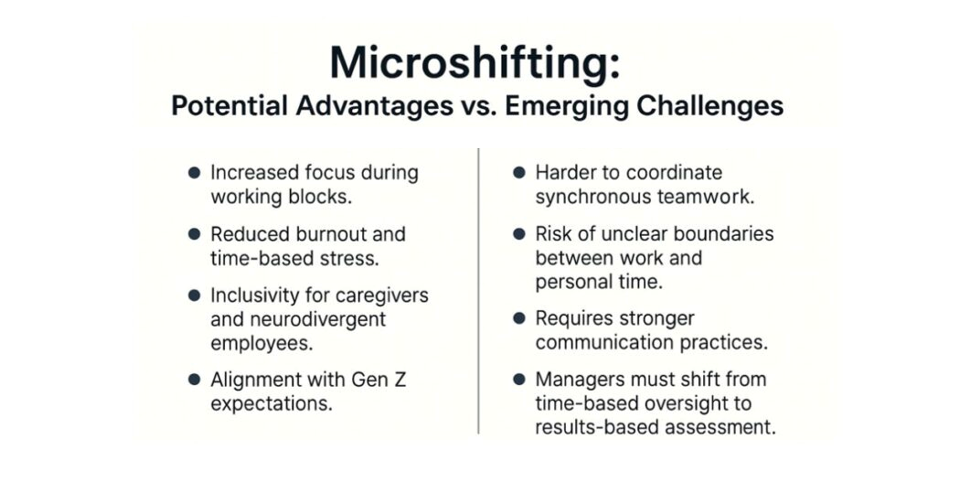The most significant workplace trend since going remote isn’t about where we work; it’s about when.
In the evolving landscape of post-pandemic work, a subtle yet significant shift is taking place; not in where people work, but when.
A growing number are embracing microshifting: breaking the traditional workday into smaller, flexible blocks that align with personal demands and peak productivity periods, rather than adhering to a strict 9-to-5.
Unlike traditional flex hours or remote work arrangements, microshifting is less about location and more about rhythm.
This type of flexibility isn’t a niche preference. Sixty-five percent of employees are interested in microshifting, and many are willing to sacrifice compensation to get it — trading up to 9% of their salary for flexible hours and 8% for a four-day workweek, according to Owl Labs’ 2025 State of Hybrid Work report.
How Microshifting Emerged: From Routine to Personal Rhythm
Microshifting isn’t an HR strategy play; it emerged organically from workers’ daily routines.
During the pandemic, employees learned they could manage work alongside caregiving, health and personal responsibilities in overlapping intervals rather than fixed shifts.
For many workers, this demonstrated that productivity is rooted in outcomes, not constant presence.
As organizations return to more structured environments, many employees are struggling to relinquish that autonomy.
Flexibility has evolved from a benefit to a core performance enabler — part of how today’s workforce operates.
A demographic shift is accelerating this change. Gen Z, entering the workplace in large numbers, places a high value on time sovereignty.
Having grown up with asynchronous learning and self-directed digital workflows, they’re pushing back on the notion that productivity must occur within rigid hours or at a single location.
For HR leaders, this signals that time flexibility is now a competitive differentiator in talent attraction, engagement and retention.
How Microshifting Works in Practice
Microshifting restructures the workday from a single linear block into a series of intentional segments.
Instead of clocking a continuous 9-to-5, an employee might begin the morning with focused work, pause midday to manage personal responsibilities such as errands, caregiving or appointments, and return later in the afternoon or evening to complete strategic tasks or deep project work.
The total hours worked often match, or even exceed, a traditional day. What changes is the rhythm.
Time is distributed according to energy levels, environment and cognitive demands rather than being dictated by the clock.
In practice, microshifting can take many forms:
- Early-focus, late-finish: Deep work at dawn, personal time mid-afternoon, project work in the evening.
- Midday reset: Core hours in the morning, extended break for life demands, re-engagement in the evening.
- Segmented sprints: Multiple short work sessions designed around concentration peaks.
What looks unconventional on paper could result in higher-quality output because work aligns with when employees are mentally at their best, not just when they’re physically present.
For HR leaders, this underscores a key truth: productivity isn’t necessarily tethered to time; it’s tethered to timing.
Why Employees Gravitate Toward Microshifting
Three themes consistently surface in workforce surveys and internal feedback:
Autonomy Over Time
Employees want the freedom to manage their day around real life — medical appointments, caregiving, peak productivity windows — not clock-bound constraints.
Protection Against Burnout
The continuous, uninterrupted workday contributes to fatigue. Shorter bursts with natural breaks can restore mental clarity and reduce stress. Eighty-three percent of U.S. workers suffer from work-related stress, and 54% of workers report that work stress affects their home life.
Personalization of Productivity
Not everyone works best in the late morning. Some people produce their most strategic thinking early, while others do so later. Microshifting gives room for individual patterns rather than enforcing uniformity.
The Benefits Business Leaders Are Observing
While microshifting is an employee-driven trend, leaders are beginning to observe tangible effects — some positive, some complicated.
Cultural and Operational Challenges
The core tension microshifting introduces is coordination. Teams built around real-time collaboration may find asynchronous rhythms challenging.
Without explicit norms, such as core hours, response expectations, and defined deliverables, misalignment can grow.
Additionally, while employees may enjoy flexibility, some struggle with overwork as the boundary between work time and personal time thins. Leaders have expressed concern that “always on” may be mistaken for freedom.
This is where thoughtful internal structure becomes essential. Not control, rather, clarity.
Is Microshifting a Trend or a Transition?
Microshifting is unlikely to replace traditional schedules entirely, nor is it suited to every job.
Roles dependent on workflow synchronization or in-person presence, such as manufacturing, clinical work and frontline operations, may never fully adopt such patterns.
But in knowledge work sectors, like technology, marketing, finance, and consulting, it’s quickly becoming normalized.
Microshifting is an adaptation. More importantly, it signals something larger: a shift in how employees define a “good job.”
Flexibility, once symbolic of privilege, is becoming a baseline expectation for a competitive employment brand.
The Takeaway for HR and Leadership
Microshifting does not demand immediate policy change. But it does call for observation, awareness and open dialogue.
Leaders will need to consider:
- How do we measure performance — hours or outcomes?
- Do our tools support asynchronous collaboration?
- Are our managers equipped to lead distributed time, not just distributed teams?
Whether organizations choose to formalize it or not, microshifting is already influencing how employees structure their workday. Understanding it is no longer optional; it’s part of understanding the workforce itself.
Give Employees More Than Flexibility: Give Them Time Back
Flexibility doesn’t mean life slows down. Best Upon Request’s employee concierge programs support your workforce by handling the errands, appointments and everyday life admin that fuel burnout. From healthcare to corporate teams, we help employees reclaim time, reduce stress and refocus on what matters most — at work and at home.
Learn how concierge support can become your most human employee benefit.
